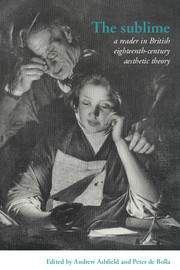Introduction
Published online by Cambridge University Press: 05 June 2012
Summary
The history of the concept of the aesthetic has yet to be written; any such history will need to examine a number of signal moments which, it would be fairly uncontroversial to claim, must include classical discussions of representation, renaissance treatments of mimesis, nineteenth-century revaluations of aestheticism and our own postmodern defamiliarisations of the artwork. Yet, important as these moments are, modern scholarship has elevated the eighteenth-century tradition of the sublime to the principal event in this long history. Indeed it has become something of a commonplace to suggest that aesthetics began during the enlightenment. Such claims clearly beg a number of difficult questions, most importantly perhaps, the precise definition of the term ‘aesthetics’. For it cannot make much sense to claim that from classical times to the eighteenth century there had been no discussion of the epistemology of the artwork, or the relationship between a representation and its representamen, or the relative values of specific art forms. Of course such discussion took place, and of course a variety of theories, some simple and some rather complex, were produced to account for that area of human activity we engage in when producing, evaluating or encountering artworks.
Consequently the claim that aesthetics began in the eighteenth century must mean something slightly different; perhaps the simplest way of conveying that difference is to call to mind the great revolutions of the enlightenment, changes in the ways in which man conceptualised himself, his relations to others and to the world outside and around him, which essentially construct the topography of modernity.
- Type
- Chapter
- Information
- The SublimeA Reader in British Eighteenth-Century Aesthetic Theory, pp. 1 - 16Publisher: Cambridge University PressPrint publication year: 1996
- 4
- Cited by

